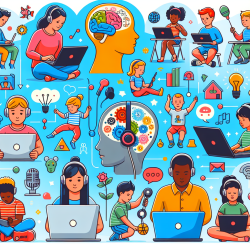Introduction
In the realm of child development and education, understanding the cognitive underpinnings of skills such as programming is crucial. A recent study, "Programming ability prediction: Applying an attention-based convolutional neural network to functional near-infrared spectroscopy analyses of working memory," sheds light on the relationship between working memory and programming ability. This research offers valuable insights that can be applied to improve educational outcomes for children, particularly in enhancing their programming skills.
Understanding the Study
The study utilized functional near-infrared spectroscopy (fNIRS) to measure prefrontal hemodynamic responses during an n-back working-memory task. It involved 35 participants divided into novice and advanced programming groups. The results revealed that advanced students had a higher working-memory capacity, which correlated with better programming skills. The study also employed an attention-based convolutional neural network (CNN) to analyze fNIRS signals, highlighting the left prefrontal cortex's significant role in programming ability prediction.
Key Findings
- Working Memory and Programming Ability: The study validated the hypothesis that a higher working-memory capacity is associated with better programming skills.
- Neural Efficiency: Advanced students showed less activation in the prefrontal cortex during tasks, indicating more efficient neural processing.
- Left Prefrontal Cortex: This brain region was identified as crucial for programming ability, as revealed by the attention-based CNN analysis.
Implications for Practitioners
For practitioners in speech language pathology and education, these findings offer actionable insights:
- Focus on Working Memory: Incorporate activities that enhance working memory in educational programs. Techniques such as memory games, puzzles, and tasks that require holding and manipulating information can be beneficial.
- Utilize Neuroimaging Insights: Consider collaborating with neuroscientists to integrate neuroimaging techniques like fNIRS in educational research and practice. This can help in tailoring interventions that target specific brain regions involved in cognitive tasks.
- Data-Driven Approaches: Use data-driven methods to assess and track cognitive development in children. This can inform personalized educational strategies that cater to individual strengths and weaknesses.
Encouraging Further Research
The study opens avenues for further research into the neural mechanisms underlying cognitive skills. Practitioners are encouraged to explore the use of advanced neural network models and neuroimaging techniques to deepen our understanding of how children learn and develop complex skills like programming.
To read the original research paper, please follow this link: Programming ability prediction: Applying an attention-based convolutional neural network to functional near-infrared spectroscopy analyses of working memory.










